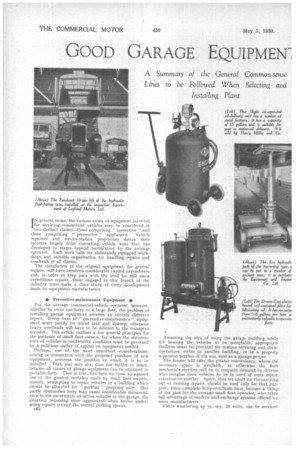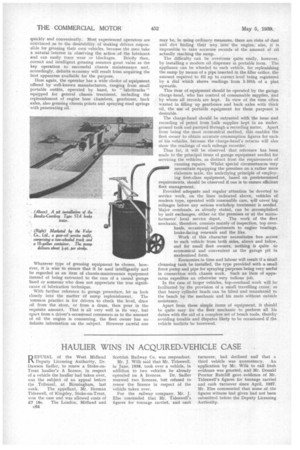GOOD GARAGE EQUIPMENT
Page 112

Page 113

Page 114

If you've noticed an error in this article please click here to report it so we can fix it.
066 A SOUN
INVESTMENT
A Summary of the General Common-sense Lines to be Followed When Selecting and InstallEng Plant
By
Richard Twelvetrecs, A.M.I.Mcch.E.
I N general terms, the various forms of equipment intefor servicing commercial vehicles may be considered in
mlexl two distinct classes—those comprising " corrective " and those comprising " preventive" appliances. Vehicle repairers and service-station proprietors derive their incomes largely from correcting vehicle wear that has developed to stages beyond rectification by the average operator. Such work calls for elaborately equipped workshops and suitable organization for handling repairs and overhauls of all classes.
The installation of the original equipment, for general repairs, will have involved considerable capital expenditure and, in order to keep pace with the need for still more expeditious repairs, those engaged in this branch of the industry must make a close study of every development made by equipment manufacturers.
• Preventive-maintenance equipment •
For the average commercial-vehicle operator, however, whether he owns one lorry or a large fleet, the problem of installing garage equipment assumes an entirely different aspect. Every item of " preventive-maintenance " equipment must justify its initial cost and upkeep, otherwise heavy overheads will have to be debited to the transport account. This article outlines a few general principles for the guidance of small fleet owners, for whom the maintenance of vehicles in roadworthy condition must be governed by a judicious outlay of capital on equipment needed.
Perhaps, one of the most important considerations, arising in connection with the proposed purchase of new equipment, concerns the position in which it is to be installed. That, you may say, does not matter so much, because all classes of garage equipment can be obtained in portable form. That is true, but here we come up against one of the greatest mistakes made by small fleet owners, namely, attempting to repair vehicles in a building which should be allocated for " parking " purposes only. One partly dismantled lorry may cause considerable inconvenience to the movements of active vehicles in the garage, the situation becoming more aggravated when lorries undergoing repairs occupy the normal parking spaces. c62 Assuming the idea of using the garage building solely for housing the vehicles to be acceptable, appropriate facilities must be provided for routine servicing and dockoperations, either in another building, or in a properly separated portion of the one used as a garage proper.
The former will offer the greater convenience, where the necessary space is available, as otherwise the fleet mechanic's services will he in frequent demand by drivers who imagine their vehicles to be in need of some minor attention or another. Space, thus set apart for the carrying out of running repairs, should be used only for that purpose, since complete lorry-overhauls have become a thing of the past for the average small fleet operator, who takes full advantage of modern unit-exchange systems offered by some manufacturers.
Fleets numbering up to, say, 20 units, can be serviced
by routine dock operations, in a shed large enough to accommodate one vehicle at a time. A. bench should be provided along the side where natural lighting is best,. space for the requisite servicing equipment being left on the opposite side. General convenience and utility will be enhanced if doors or shutters be arranged at both ends of the shed, giving access to a loop roadway used only by vehicles on their way to and from the building.
Before studying the various forms of equipment offered by manufacturers, it may be as well to visualize the exact purposes for which they are required and the practical factors determining their choice.
In some circumstances, the number of vehicles operated remains at a fairly constant level, whilst in others, the possibility of additions must be envisaged. This matter has a most important influence on the choice of equipment. For all practical purposes, it is better to purchase equipment with sufficient capacity to permit of more extensive use than peesent conditions appear to indicate, rather than to spend money on equipment of strictly limited utility, and which may have to be augmented or replaced entirely, at some future date. Economy in garage and workshop space is another vital consideration and, therefore, all equipment should be not only essentially compact in form, but should also he convenient to use.
Assuming a small fleet of vans or lorries to be engaged on regular work, we may look upon the garage as a place wherein they are parked at night. At the same time, adequate facilities must exist for washing, lubrication and normal daily attentions for which the drivers are made responsible, under the supervision of a garage charge-hand who remains on the premises. On returning from his day's work, each driver will hand a report to the garage charge-hand should the vehicle need anything more than routine-service attentions. That will then be a matter for the running-repair mechanic and reference to it will be made later. Vehicles subject to no adverse report. will be parked in predetermined positions and left for the night.
• Value of Power-washing Plant • On the following morning, the drivers begin the day's work by washing their own vehicles, which from most points of view is preferable to entrusting the work to garage labourers at night. The operation involves, of course, the use of power washing-plant, located in some convenient corner, and overhead pipes with hose connections to reach the individual vehicles. With regard to the cost et installing power washing-equipment and overhead pipelines. suppliers of the requisite plant are best qualified to prepare estimates to meet individual circumstances.
It may appear advisable to install pressure lines to supply grease to each of the vehicles individually. For all its importance, however, chassis lubrication is not a daily job. A careful study of any chassis-lubrication chart will enable the operator to issue instructions for certain parts to be greased on specified days of the week, whilst others will only require attention at longer intervals. The thing to do, is to estimate the amount of grease required to lubricate the entire fleet thoroughly, and then purchase a portable grease-gun, operated by hand, electric power or compressed air, as circumstances dictate.
It should be appreciated that, when handled by an intelligent driver, the grease-gun does more than supply grease quickly and conveniently. Most experienced operators are convinced as to the desirability of making drivers responsible for greasing their own vehicles, because the men take a natural interest in observing the action of the lubricant and can easily trace wear or blockages. Briefly then, correct and intelligent greasing assumes great value as the key operation to successful chassis maintenance and, • accordingly, definite economy will result from acquiring the best apparatus available for the purpose.
Here again, the operator has a wide choice of equipment offered by well-known manufacturers, ranging from small portable outfits, operated by hand, to " lubritrucks " equipped for general chassis treatment, including the replenishment of engine base chambers, gearboxes, back axles, also greasing chassis points and spraying road springs with penetrating oil.
Whatever type of greasing equipment be chosen, however, it is wise to ensure that it be used intelligently and he regarded. as an item of chassis-maintenance equipment instead of being entrusted to the care of a casual garage hand or someone who does not appreciate the true significance of lubrication technique.
With further reference to garage procedure, let us look closely into the matter of sump replenishment. The :.orrirrion practice is for drivers to check the level, draw oil from the store, or from a drum, then pour in the requisite amount. That is all very well in its way, but apart from a driver's occasional comments as to the amount of oil the engine is consuming, the fleet owner has no definite information on the subject. However careful one may be, in using ordinary measures, there are risks of dust and dirt finding their way into the engine, also, it is impossible to take accurate records of the amount of oil actually reaching the sump.
The difficulty can be overcome quite easily, however, by installing a modern oil dispenser in portable form. The appliance can be wheeled to each vehicle, for replenishing the sump by means of a pipe inserted in the filler orifice, the amount required to fill up to correct level being registered by a dial which shows readings from 1-10th of a pint upwards.
This item of equipment should be operated by the garage charge-hand, who has control of consumable supplies, and by whom all records are kept. In view of the time often wasted in filling up gearboxes and back axles with thick oil, the use of portable equipment for these purposes is desirable.
The charge-hand should be entrusted with the issue and recording of petrol from bulk supplies kept in an underground tank and pumped through a recording meter. Apart from being the most economical method, this enables the fleet owner to obtain accurate consumption figures for each of his vehicles, .because the charge-hand's returns will also show the readings of each mileage recorder.
Thus far, it will be observed that reference has been made to the principal items of garage equipment needed for servicing the vehicles, as distinct from the requirements of running repairs. Whilst special circumstances may necessitate equipping the premises on a rather more elaborate scale, the underlying principle of employing first-class equipment, based on predetermined requirements, should be observed if one is to ensure efficient fleet management.
Provided adequate and regular attention be devoted to service work, on the lines indicated above, vehicles of modern type, operated with reasonable care, will cover big mileages before any serious workshop treatment is needed. Major overhauls, as already stated, can be accomplished by unit exchanges, either on the premises or at the manu
facturers' local service depot. The work a the fleet mechanic, therefore, consists mainly of inspection, top overhauls, occasional adjustments to engine bearings, brake-facing renewals and the like.
Work of this character necessitates free access to each vehicle from both sides, above and below, and for small fleet owners, nothing is quite so economical and convenient as the garage pit in modernized form.
Economies in time and labour will result if a small cleansing tank be installed, the type provided with a small force pump and pipe for spraying purposes being very useful in connection with chassis work. Such an item of apparatus expedites an otherwise very tedious job.
In the case of larger vehicles, top-overhaul work will be facilitated by the provision of a small travelling crane, so that heavy cylinder heads can be lifted and transferred to the bench by the mechanic and his mate without outside assistance.
Apart from these simple items of equipment, it should be quite easy for the fleet mechanic to perform all his duties with the aid of a complete set of bench tools, thereby avoiding trouble and disputes likely to be occasioned if the vehicle toolkits be borrowed.
































































































































































